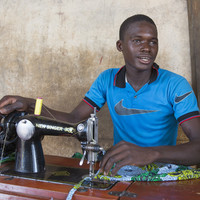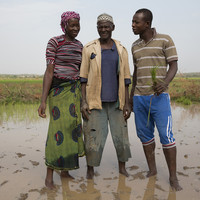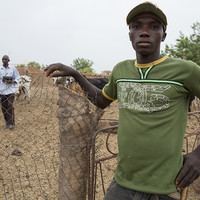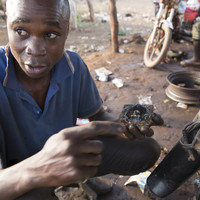For smallholders and dams, one size doesn't fit all
Photos taken for the Global Water Initiative in West Africa in villages around the Sélingué dam in Mali show that when it comes to the irrigation schemes surrounding large dams, there is no 'standard' example of a family farmer.


A farmer on his motorbike on the bank between irrigated fields. In the background, pylons carry hydroelectric power from the Sélingué dam (Photo: Mike Goldwater/GWI)
The Global Water Initiative (GWI) has been working with smallholders living near Sélingué dam since 2009 to find out how the dam affects the livelihoods of local farmers and what improvements could be made. The Sélingué dam serves a number of functions, including providing hydropower and irrigation for agriculture – primarily rice.
To reduce poverty and ensure higher levels of productivity, governments need to understand who these farmers are and how best to support them.
Diversification helps smallholders be more resilient
While the Malian government favours rice monocultures, many of the family farmers we work with grow a range of crops or earn a living from non-agricultural activities. This helps them cope with unpredictable weather conditions, as well as changing market prices. The government and family farmers' different perspectives need to be reconciled.
Farmers who lived in the area before the dam was built often have access to rain-fed plots and pasture as well as irrigated land. As a result, they have different needs in terms of land tenure and agricultural support services.
Land allocation according to family needs
Irrigation plots were allocated after the dam was built according to different criteria.
People farming around Sélingué include families displaced by the dam construction who were given plots in the irrigation scheme where they mainly grow rice; families who lived in the area before the dam was built and still have their rain-fed plots in addition to irrigated land; and migrants and retired public servants who have come to Sélingué to start farming on the irrigation scheme.
The size of plot, and the resources and advice services available, determine whether or not they can live off the land or need to rely on non-agricultural income sources.
Benefits of flexible land tenure
Not everyone is able, or best suited, to farm the land that they have. Others, who don't have access to any land, or enough to meet their needs, are seeking farm work to supplement their income or as a way of earning their living.
As the land on the irrigation scheme is public land, it cannot officially be sold, inherited or rented out, even though sometimes this would benefit both the smallholder and others. Many plot holders do hire out land for one or more cropping seasons – informally – usually because they lack resources for seed, fertiliser, labour and so on, to cultivate it themselves.
Different land tenure solutions exist that could provide more security and flexibility for farmers, such as long leases.
Responding to the needs of family farmers
If farmers are to be able to increase their productivity, level of income and improve food security, they must have access to agricultural advice and support services, as well as access to markets and to inputs such as fertiliser and seeds.
A family farming rice and cassava, or bananas, needs advice and support for all aspects of their smallholding. The particular needs of women, young people and the elderly must also be reflected and addressed.
Farmers' organisations need to play a stronger role in determining how agricultural services are provided and the dam management agencies need to recognise and be accountable to these organisations. Many of these changes require policymakers to make 'soft' rather than 'hard' investments – in communication and training as well as fertiliser and machinery.
Event:
IIED and its partners held a side event, titled 'Towards socially just and economically viable dams in West Africa', at World Water Week 2015 in Stockholm, Sweden from 23-28 August, 2015 to share some of the lessons learnt from the work of the GWI in West Africa, and exchange experiences with others from across the globe about how to make large multi-purpose dams more 'socially just and economically viable'.















